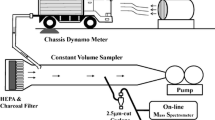Abstract
There is no shortage of information about the average benzene concentrations in urban air, but there is very little about microenvironmental exposure, such as in-vehicle concentrations while driving in various traffic conditions, while refuelling, or while in a parking garage. The main reason for this lack of data is that no analytical instrumentation has been available to measure on-line trace amounts of benzene in such situations. We have recently proposed a highly accurate, high-speed cryofocusing gas chromatography/mass spectrometry (GC/MS) system for monitoring benzene concentrations in air. Accuracy of the analytical data is achieved by enrichment of the air sample before trapping, with a stable isotope permeation tube system. The same principles have been applied to a new instrument, specifically designed for operation on an electric vehicle (Ducato Elettra, Fiat). The zero emission vehicle and the fully transportable, battery-operated GC/MS system provide a unique possibility of monitoring benzene exposure in real everyday situations such as while driving, refuelling, or repairing a car. All power consumptions have been reduced so as to achieve a battery-operated GC/MS system. Liquid nitrogen cryofocusing has been replaced by a packed, inductively heated, graphitized charcoal microtrap. The instrument has been mounted on shock absorbers and installed in the van. The whole system has been tested in both fixed and mobile conditions. The maximum monitoring period without external power supply is 6 h. The full analytical cycle is 4 min, allowing close to real-time monitoring, and the minimum detectable level is 1 μg/m3 for benzene. In-vehicle monitoring showed that, when recirculation was off and ventilation on, i.e., air from outside the vehicle was blown inside, concentrations varied widely in different driving conditions: moving from a parking lot into normal traffic on an urban traffic condition roadway yielded an increase in benzene concentration from 17 to 62.3 μg/m3 even if the actual distance was small. A larger increase was observed when a car was left with the engine running at a distance 2 m from the zero emission vehicle: We measured an increment of benzene concentrations from 15.2 to 174.4 μg/m3 with a car equipped with a catalytic converter, and from 19.1 to 386.3 μg/m3 with a car without such a converter.
Similar content being viewed by others
References
Air quality standards: benzene (1994) HMSO, London
Brunnemann KD, Kagan MR, Cox JE, Hoffmann D (1990) Analysis of 1,3-butadiene and other selected gas-phase components in cigarette mainstream and sidestream smoke by gas chromatography-mass selective detection. Carcinogenesis 11:1863–1868
Chan CC, Ozkaynak H, Spengler JD, Sheldon L (1991) Driver exposure to volatile organic compounds, CO, ozone and NO2 under different driving conditions. Environ Sci Technol 25:964–972
Davoli E, Cappellini L, Moggi M, Fanelli R (1994) Automated high-speed analysis of selected organic compounds in urban air by on-line isotopic dilution cryofocusing gas chromatography/mass spectrometry. J Am Soc Mass Spectrometry 5:1001–1007
Davoli E, Leone A, Stramare L, Fanelli R (1995) Campionamento e determinazione di idrocarburi volatili in aria: l'impiego della spettrometria di massa con diluizione con isotopi stabili come possible metodo di riferimento. In: Minoia C, Apostoli P, Bartolucci GB (eds) II benzene: tossicologia, ambienti di vita e di lavoro. Morgan Edizioni Techniche, Milan, pp 283–289
Davoli E, Passagrilli C, Stramare L, Fanelli R (1994) Sampling and determination of VOC in environmental air: stable isotope dilution mass spectrometry as a candidate reference method. Proceedings of the 42nd ASMS Conference on mass spectrometry and allied topics. Chicago, 29 May–3 June 1994
Davoli E, Rossi O, Fanelli R (1993) A candidate reference method for automated analysis of selected organic compounds in urban air. In: Ciccioli P (ed) Atti 1° Simposio Nazionale sulle Strategie e Tecniche di Monitoraggio dell'Atmosfera, Rome, 20–22 September 1993. Società Chimica Italiana, Rome, pp 447–456
Davoli E, Rossi O, Fanelli R (1993) Stable isotope permeation tubes for GC-MS analysis of VOC in air. J High Res Chromatogr 16:626–628
Decreto Ministeriale 25 Novembre 1994. Aggiornamento delle norme tecniche in materia di limiti di concentrazione e di livelli di attenzione e di allarme per gli inquinanti atmosferici nelle aree urbane c disposizioni per la misura di alcuni inquinanti di cui al DM del 14 aprile 1994. Ministro dell'Ambiente e Ministero della Sanità, Rome
Foà V (1994) Per il benzene è allarme rosso. Impresa Ambiente 8:6–10
Lioy PJ (1990) Assessing total human exposure to contaminants. Environ Sci Technol 24:938–945
Russell M, Gruber M (1987) Risk assessment in environmental policy-making. Science 236:286–290
Seinfeld JH (1989) Urban air pollution: state of the science. Science 243:745–752
U.S. Environmental Protection Agency (1992) Motor vehicle-related air toxics study. Public Review Draft, December 1992
Wallace LA (1989) The exposure of the general population to benzene. Cell Biol Toxicol 5:297–314
World Health Organization (1987) IARC monographs on the evaluation of carcinogenic risks to humans, supplement 7: overall evaluations of carcinogenicity: an updating of IARC monographs volumes 1 to 42. IARC, Lyon
Author information
Authors and Affiliations
Rights and permissions
About this article
Cite this article
Davoli, E., Cappellini, L., Moggi, M. et al. On-line monitoring of benzene air concentrations while driving in traffic by means of isotopic dilution gas chromatography/mass spectrometry. Int. Arch Occup Environ Heath 68, 262–267 (1996). https://doi.org/10.1007/BF00381438
Received:
Accepted:
Issue Date:
DOI: https://doi.org/10.1007/BF00381438




